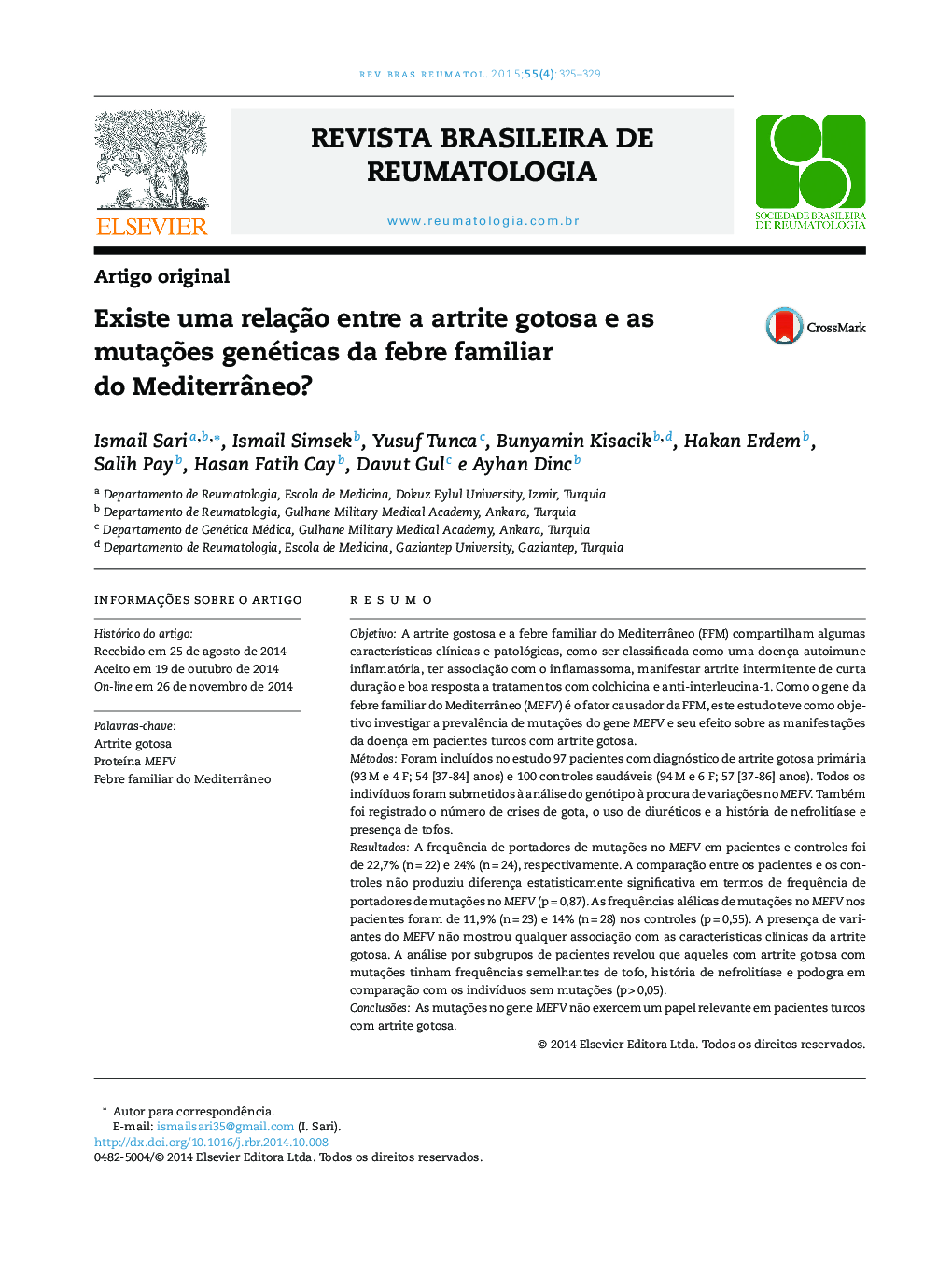| Article ID | Journal | Published Year | Pages | File Type |
|---|---|---|---|---|
| 3326994 | Revista Brasileira de Reumatologia | 2015 | 5 Pages |
ResumoObjetivoA artrite gostosa e a febre familiar do Mediterrâneo (FFM) compartilham algumas características clínicas e patológicas, como ser classificada como uma doença autoimune inflamatória, ter associação com o inflamassoma, manifestar artrite intermitente de curta duração e boa resposta a tratamentos com colchicina e anti‐interleucina‐1. Como o gene da febre familiar do Mediterrâneo (MEFV) é o fator causador da FFM, este estudo teve como objetivo investigar a prevalência de mutações do gene MEFV e seu efeito sobre as manifestações da doença em pacientes turcos com artrite gotosa.MétodosForam incluídos no estudo 97 pacientes com diagnóstico de artrite gotosa primária (93 M e 4 F; 54 [37‐84] anos) e 100 controles saudáveis (94 M e 6 F; 57 [37‐86] anos). Todos os indivíduos foram submetidos à análise do genótipo à procura de variações no MEFV. Também foi registrado o número de crises de gota, o uso de diuréticos e a história de nefrolitíase e presença de tofos.ResultadosA frequência de portadores de mutações no MEFV em pacientes e controles foi de 22,7% (n = 22) e 24% (n = 24), respectivamente. A comparação entre os pacientes e os controles não produziu diferença estatisticamente significativa em termos de frequência de portadores de mutações no MEFV (p = 0,87). As frequências alélicas de mutações no MEFV nos pacientes foram de 11,9% (n = 23) e 14% (n = 28) nos controles (p = 0,55). A presença de variantes do MEFV não mostrou qualquer associação com as características clínicas da artrite gotosa. A análise por subgrupos de pacientes revelou que aqueles com artrite gotosa com mutações tinham frequências semelhantes de tofo, história de nefrolitíase e podogra em comparação com os indivíduos sem mutações (p > 0,05).ConclusõesAs mutações no gene MEFV não exercem um papel relevante em pacientes turcos com artrite gotosa.
ObjectiveGouty arthritis and familial Mediterranean fever (FMF) share some clinical and pathological features such as being classified as auto inflammatory disease, association with inflammasome, short‐lived intermittent arthritis, and good response to colchicine and anti‐interleukin‐1 treatments. As Mediterranean fever (MEFV) gene is the causative factor of FMF, we aimed to investigate the prevalence of MEFV gene mutations and their effect on disease manifestations in Turkish gouty arthritis patients.MethodsNinety‐seven patients diagnosed with primary gouty arthritis (93 M and 4 F, 54 [37‐84] years) and 100 healthy controls (94 M and 6 F, 57 [37‐86] years) included in the study. All subjects were genotyped for the MEFV variations. Number of gout attacks, diuretic use, and history of nephrolithiasis and presence of tophus were also recorded.ResultsThe carriage rate of MEFV mutations for patients and controls were 22.7% (n = 22) and 24% (n = 24) respectively. The comparison of the patient and control groups yielded no significant difference in terms of the MEFV mutations carriage rate (p = 0.87). The allelic frequencies of the MEFV mutations in patients were 11.9% (n = 23) and 14% (n = 28) in controls (p = 0.55). The presence of MEFV variants did not show any association with clinical features of gouty arthritis. The subgroup analysis of patients revealed that gouty arthritis patients with mutations had similar frequencies of tophus, history of nephrolithiasis and podogra compared to the ones without mutations (p > 0.05).ConclusionsThis study does not provide support for a major role of MEFV mutations in Turkish gouty arthritis patients.
